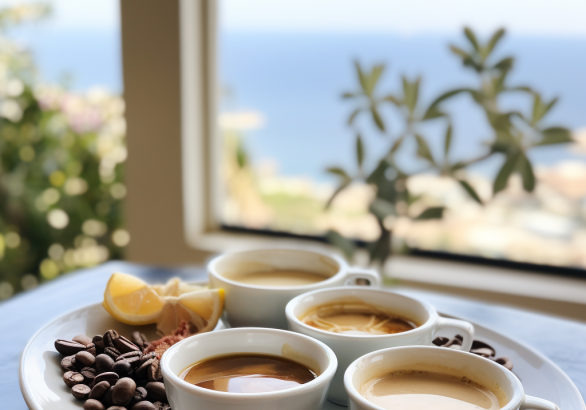Are you a coffee lover? If so, you’re in for a treat! Get ready to embark on a journey through the delightful world of Greek coffee. Ranked as one of the top 10 coffee varieties in the world, Greek coffee offers a unique and refreshing twist on your favorite caffeinated beverage. Among the top contenders are freddo cappuccino, a chilled coffee concoction that blends espresso with ice and frothy milk, and espresso freddo, a simple yet smooth combination of espresso and ice. And who can forget about the iconic frappe, a beloved Greek invention that combines instant coffee with water and ice, resulting in a frothy foam-filled delight. So, sit back, relax, and discover the top 10 Greek coffee varieties that are sure to delight your taste buds.

Freddo Cappuccino
Origin and Introduction
Freddo cappuccino is a delightful chilled coffee variety that hails from Greece. It has gained popularity all over the world due to its refreshing and creamy taste. This beverage is made with a double shot of espresso that is blended with ice, strained, and then poured over more ice. The final touch is the addition of well-chilled milk that is shaken or blended to create a light and frothy consistency.
Ingredients
To make a perfect freddo cappuccino, you will need the following ingredients:
- Espresso (double shot)
- Ice cubes
- Chilled milk
Preparation
The process of preparing a freddo cappuccino is fairly simple. Start by brewing a double shot of espresso using your preferred method. Let it cool for a few minutes. In a blender or shaker, combine the espresso with a handful of ice cubes. Blend or shake vigorously until the coffee and ice are well combined and the drink becomes chilled and frothy.
Once you have the chilled coffee mixture, pour it over a glass filled with ice cubes. Then, top it off with a generous amount of chilled milk. For an added touch, you can also dust some cocoa powder or cinnamon on top.
Serving
Freddo cappuccino is typically served in a tall glass. It is perfect for enjoying on a hot summer day or whenever you crave a refreshing pick-me-up. You can also serve it with a straw for easier sipping, if desired.
Taste and Texture
The taste of freddo cappuccino is a delightful combination of strong espresso, creamy milk, and a hint of sweetness. It offers a perfect balance of flavors, making it suitable for both coffee lovers and those who enjoy a lighter coffee taste. The texture is smooth and frothy, thanks to the blending or shaking process.
Popular Variations
While the classic freddo cappuccino is a delight in itself, there are some popular variations that you can try. For a sweeter twist, you can add a flavored syrup such as vanilla or caramel. Alternatively, you can also experiment with different types of milk, such as almond, soy, or oat milk, to give your freddo cappuccino a unique twist.
Espresso Freddo
Origin and Introduction
Espresso freddo is a popular Greek coffee variety that has gained recognition worldwide. Unlike other iced coffee beverages that simply involve pouring coffee over ice, espresso freddo takes it a step further by blending the espresso with ice until it becomes slightly chilled, smooth, and creamy.
Ingredients
The ingredients required to make espresso freddo are minimal. You will need:
- Espresso
- Ice cubes
Preparation
To prepare a delicious espresso freddo, start by brewing a shot of espresso using your preferred method. Allow the espresso to cool down for a few minutes. Fill a blender or shaker with a handful of ice cubes and add the espresso on top. Blend or shake vigorously until the coffee and ice are well combined and the drink reaches a slightly chilled and creamy consistency.
Serving
Espresso freddo is traditionally served in a tall glass. The smooth and creamy texture of this coffee makes it a perfect treat for a hot summer day. You can enjoy it as is or add a sweetener or flavored syrup of your choice to enhance the taste.
Taste and Texture
The taste of espresso freddo is rich and intense, thanks to the concentrated flavors of the espresso. It offers a well-balanced combination of bitterness and sweetness that coffee enthusiasts appreciate. The texture is smooth and creamy, making it a delight to sip on.
Popular Variations
If you want to experiment with different flavors, you can add a scoop of vanilla or chocolate ice cream to your espresso freddo. This variation adds a creamy and indulgent touch to the already delightful drink. Additionally, you can try using different types of espresso beans to achieve unique flavor profiles.
Frappe
Origin and Invention
The frappe, despite its name, is not a French creation. It was actually invented in Greece in 1957 by a Nescafe representative named Dimitris Vakondios during the International Fair in Thessaloniki. The story goes that Vakondios was looking for a quick way to make iced coffee and decided to experiment by shaking instant coffee, water, and ice together. This accidental invention quickly became a hit and has since become a beloved Greek coffee variety.
Ingredients
To make a classic frappe, you will need the following ingredients:
- Instant coffee
- Cold water
- Ice cubes
- Sugar (optional)
- Milk (optional)
Preparation
Making a frappe is a breeze. In a shaker or hand mixer, combine one teaspoon of instant coffee, a small amount of cold water, and sugar (if desired). Shake or mix vigorously until the mixture becomes frothy and resembles a foam.
Next, fill a glass with ice cubes and pour the coffee foam over it. If you prefer a sweeter taste, you can add sugar and mix it in before pouring it over the ice. You can also add milk if you prefer a creamier frappe.
Serving
Frappe is traditionally served in a tall glass, similar to other iced coffee beverages. It is a popular choice during hot summer days or as a refreshing pick-me-up. Some people prefer to enjoy their frappe with a straw, while others opt to sip it directly from the glass.
Taste and Texture
The taste of frappe is characterized by its strong and smooth coffee flavor. It has a slightly creamy texture due to the frothy foam created during its preparation. It offers a delightful balance of sweetness and bitterness, making it a staple in Greek coffee culture.
Popular Variations
While the classic frappe remains a favorite, there are a few variations you can explore. For a sweeter frappe, you can add flavored syrups such as vanilla, caramel, or hazelnut. Additionally, you can experiment with different types of milk, such as almond or soy milk, for a non-dairy alternative. Some also like to top their frappe with a dollop of whipped cream for added indulgence.

Greek frappe
Origin and Popularity
The Greek frappe, also known as café frappé, is a beloved coffee beverage that originated in Greece in the 1950s. It quickly gained popularity and has become an iconic part of Greek coffee culture. The frappe is commonly enjoyed throughout Greece, whether at cafes or made at home.
Ingredients
To make a Greek frappe, you will need the following ingredients:
- Instant coffee
- Cold water
- Ice cubes
- Sugar (optional)
- Milk (optional)
Preparation
Creating a refreshing Greek frappe is a straightforward process. Begin by adding one or two teaspoons of instant coffee to a shaker or a tall glass. If desired, you can also add sugar for a sweeter taste. Pour a small amount of cold water into the shaker or glass and stir vigorously until the coffee and sugar have dissolved.
Next, fill the shaker or glass with ice cubes and add water up to the desired level. Shake or stir vigorously until the mixture becomes frothy. You can adjust the levels of coffee, sugar, and water to suit your taste preferences. If desired, you can also add milk for a creamy twist.
Serving
A Greek frappe is traditionally served in a tall glass with a straw. It is perfect for enjoying on warm sunny days or as a refreshing beverage throughout the year. Feel free to garnish with a dusting of cocoa powder, cinnamon, or whipped cream for an extra touch of indulgence.
Taste and Texture
The Greek frappe offers a delightful combination of rich coffee flavor and a hint of sweetness. The texture is creamy, thanks to the frothy foam created during preparation. It is a refreshing and satisfying beverage that can be enjoyed throughout the day.
Popular Variations
The classic Greek frappe is loved for its simplicity, but there are variations for those looking to add their own twist. Some like to enhance the flavor by using flavored syrups such as vanilla or caramel. Others prefer to use different types of milk like almond, soy, or oat milk as a dairy-free alternative. Feel free to personalize your frappe to suit your taste preferences and enjoy a unique take on this beloved Greek coffee beverage.
Loumidis
Origin and History
Loumidis coffee holds a special place in Greek coffee culture, thanks to its rich history. It was originally founded by Pavlos Loumidis in 1919 and has since become a beloved coffee brand in Greece. Loumidis coffee is made from a blend of high-quality arabica and robusta coffee beans that are roasted in a traditional manner.
Ingredients
To prepare a cup of Loumidis coffee, you will need:
- Loumidis coffee grounds
- Water
Preparation
Making Loumidis coffee is a traditional and cherished process. Begin by adding one heaping teaspoon of Loumidis coffee grounds per cup of water into a briki, a traditional Greek coffee pot. Add sugar according to your taste preferences, typically one teaspoon per cup.
Place the briki over low heat and slowly heat the mixture while stirring, until the coffee and sugar have dissolved. Be careful not to let it boil. Once the coffee is dissolved, increase the heat slightly to allow it to create a thick foam on top. Remove the briki from heat when the foam rises near the rim of the pot, but before it overflows, allowing the foam to settle.
Serving
Loumidis coffee is typically served in demitasse cups, which are small and handleless espresso cups. It is often enjoyed alongside a glass of cold water to cleanse the palate before and after sipping the strong and flavorful coffee. This traditional coffee experience is perfect for sharing with friends or family, fostering a sense of togetherness.
Taste and Aroma
Loumidis coffee is known for its strong and robust flavor. It offers a rich and deep brew that is full-bodied with a hint of bitterness. The aroma is enticing, filling the room with the fragrant scent of freshly brewed coffee. It provides a unique and traditional Greek coffee experience.
Popular Variations
While Loumidis coffee is celebrated for its traditional brewing process, you can add a personal touch to your cup of Loumidis by sprinkling cinnamon or cardamom on top before serving. These spices add a delightful aroma and an extra layer of flavor to the already exquisite coffee.
Ellinikos
Origin and Tradition
Ellinikos, also known as Greek coffee, holds a special place in Greek culture and remains deeply rooted in tradition. It is prepared using a special brewing method that has been passed down through generations. Greek coffee is often enjoyed during social gatherings, and its preparation showcases the hospitality and warmth of Greek hospitality.
Ingredients
To prepare a cup of Ellinikos, you will need the following ingredients:
- Greek coffee grounds
- Water
- Sugar (optional)
Preparation
Creating a perfect cup of Ellinikos requires a briki, a traditional Greek coffee pot. Begin by adding water to the briki, using the demitasse cups as a gauge to measure the desired number of cups. For each cup of water, add one heaping teaspoon of Greek coffee grounds into the briki. Add sugar according to your taste preferences.
Place the briki on low heat and stir gently to mix the coffee and sugar into the water. Allow the coffee mixture to heat gradually, making sure not to let it boil. As the coffee heats, it will begin to create a thick foam on top. Once the foam rises near the rim of the pot, but before it overflows, remove the briki from the heat.
Serving
Ellinikos coffee is traditionally served in small demitasse cups. It is often accompanied by a glass of water to cleanse the palate and enhance the enjoyment of the robust coffee flavors. Take your time to savor the coffee and embrace the traditional ritual of Greek coffee drinking.
Taste and Aroma
Ellinikos offers a unique and distinctive taste profile that sets it apart from other coffee varieties. It has a full-bodied flavor with a rich and earthy taste. The aroma is deep and captivating, filling the air with the comforting scent of freshly brewed coffee. Greek coffee encourages a slow and mindful drinking experience.
Popular Variations
While Ellinikos coffee is celebrated for its traditional preparation, there are some variations you can try to add a personal touch. Some like to enhance the flavor by adding cardamom or cinnamon to the coffee grounds before brewing. These spices infuse the coffee with delightful aromas and an additional layer of complexity.
Metrios
Origin and Characteristics
Metrios is a middle-ground coffee, often described as medium roast, with a balanced flavor profile. It is a popular choice among coffee enthusiasts in Greece who prefer a milder taste compared to the strong and bold Greek coffee varieties.
Ingredients
To make a cup of Metrios, you will need:
- Metrios coffee grounds
- Water
- Sugar (optional)
Preparation
Preparing Metrios coffee follows a similar process to Ellinikos coffee. Start by adding water to a briki, using the demitasse cups as a reference for the desired number of cups. For each cup of water, add one heaping teaspoon of Metrios coffee grounds into the briki. You can also add sugar to taste if desired.
Place the briki over low heat and gently stir the coffee and sugar into the water. Allow the coffee to heat gradually, avoiding boiling. As the coffee heats, it will build a foamy layer on top. When the foam reaches near the rim of the pot without overflowing, remove the briki from the heat.
Serving
Metrios coffee is traditionally served in small demitasse cups. Like other Greek coffee varieties, it is often enjoyed alongside a glass of water. Take your time to enjoy the subtle flavors of Metrios and appreciate the balanced taste that it offers.
Taste and Aroma
Metrios coffee is known for its smooth and balanced flavor. It provides a milder taste compared to stronger Greek coffee varieties, making it a great choice for those who prefer a more delicate coffee experience. The aroma is pleasant and inviting, adding to the overall enjoyment of the coffee.
Popular Variations
While the classic Metrios coffee is favored for its balanced taste, you can experiment with the brewing process to customize your cup. Adjust the amount of coffee grounds and sugar according to your taste preferences. You can also try adding a dash of cinnamon or nutmeg for a subtle yet delightful twist to your Metrios coffee.
Se gouda
Origin and Significance
Se gouda, also known as Greek filter coffee, is a traditional coffee variety that holds a significant place in Greek coffee culture. It is prepared using a unique brewing method that involves allowing the coffee grounds to steep in hot water before being served.
Ingredients
To make a cup of se gouda, you will need:
- Se gouda coffee grounds
- Water
- Sugar (optional)
Preparation
Preparing se gouda requires a special coffee pot known as a gouda. Begin by adding water to the gouda, using the demitasse cups as a measurement for the desired number of cups. For each cup of water, add one heaping teaspoon of se gouda coffee grounds to the gouda. Add sugar according to your taste preferences.
Place the gouda over low heat and gently stir the coffee and sugar into the water. Allow the coffee to heat gradually, without letting it boil. As the water heats, the coffee grounds will settle at the bottom of the pot, creating a concentrated coffee. Once the coffee is ready, remove the gouda from the heat.
Serving
Se gouda is traditionally served in small demitasse cups. To serve, gently pour the brewed coffee into the cups, taking care not to disturb the settled coffee grounds at the bottom of the gouda. Savor the rich and robust flavors of se gouda while appreciating the traditional brewing method.
Taste and Aroma
Se gouda offers a bold and intense flavor profile that coffee enthusiasts appreciate. It has a decadent and full-bodied taste, with a depth of flavor that comes from the steeping process. The aroma is enticing and aromatic, filling the air with the rich scent of freshly brewed coffee.
Popular Variations
While se gouda is renowned for its traditional preparation, you can experiment with the brewing process to suit your taste preferences. Adjust the amount of coffee grounds and sugar according to your preferences. Additionally, you can try adding spices like cinnamon or cardamom to the coffee grounds before brewing to add depth and complexity to your se gouda.
Ellinikos kafes
Origin and Culture
Ellinikos kafes, also known as traditional Greek coffee, is deeply rooted in Greek culture and traditions. It has been a beloved part of Greek coffee culture for centuries and holds a special place in Greek hospitality.
Ingredients
To make a cup of Ellinikos kafes, you will need the following ingredients:
- Ellinikos kafes coffee grounds
- Water
- Sugar (optional)
Preparation
Preparing Ellinikos kafes follows a unique and traditional brewing process. Begin by adding water to a briki, using the demitasse cups as a reference for the desired number of cups. For each cup of water, add one heaping teaspoon of Ellinikos kafes coffee grounds into the briki. Add sugar according to your taste preferences.
Place the briki over low heat and gently stir the coffee and sugar into the water. Allow the coffee to heat gradually, making sure not to let it boil. The coffee will begin to create a thick foam on top. Once the foam rises near the rim of the pot without overflowing, remove the briki from the heat.
Serving
Ellinikos kafes is traditionally served in small demitasse cups. It is customary to drink the coffee slowly, allowing the grounds to settle at the bottom of the cup. Alongside the coffee, a glass of water is often served to cleanse the palate and enhance the flavors of the coffee.
Taste and Aroma
Ellinikos kafes offers a distinctive taste and aroma that sets it apart from other coffee varieties. It has a bold and robust flavor, with a rich and earthy taste that reflects the unique brewing process. The aroma is enticing and fills the air with the comforting scent of freshly brewed coffee.
Popular Variations
While Ellinikos kafes is celebrated for its traditional preparation, you can personalize your cup of coffee by adding spices like cardamom or cinnamon to the coffee grounds before brewing. These spices infuse the coffee with delightful aromas and add layers of flavor to enhance your coffee experience.
Glyka
Origin and Sweetness
Glyka, also known as Greek sweet coffee, is a delightful and indulgent coffee variety that satisfies coffee lovers with a sweet tooth. It is known for its sugary deliciousness and the ability to provide a comforting treat during any time of the day.
Ingredients
To make a cup of glyka, you will need:
- Glyka coffee grounds
- Water
- Sugar
Preparation
Preparing glyka coffee is similar to other Greek coffee varieties but with an extra touch of sweetness. Begin by adding water to a briki and using the demitasse cups to measure the desired number of cups. For each cup of water, add one heaping teaspoon of glyka coffee grounds into the briki. Then, add the desired amount of sugar. The sweetness can vary based on personal preferences.
Place the briki over low heat and gently stir the coffee and sugar into the water. Allow the coffee to heat gradually, without letting it boil. As the coffee heats, it will create a thick foam on top. Once the foam rises near the rim of the pot without overflowing, remove the briki from the heat.
Serving
Glyka coffee is traditionally served in small demitasse cups. The sweet coffee is enjoyed alongside a glass of water, providing a contrast to cleanse the palate. Take your time to savor the sugary goodness and indulge in the comforting taste of glyka.
Taste and Texture
Glyka coffee is all about sweetness. It offers a rich and velvety taste that is delightfully sweet and comforting. The sugar adds a smoothness to the coffee, creating a luscious texture. It is the perfect choice for those who enjoy a touch of indulgence in their coffee.
Popular Variations
While glyka coffee is already sweet in its traditional preparation, you can experiment with different levels of sweetness by adjusting the amount of sugar added. You can also try adding a hint of vanilla or caramel syrup to enhance the flavor and add extra depth to your cup of glyka. Let your taste buds guide you in finding the perfect balance of sweetness that suits your preferences.
- Dive into the Greek Coffee Culture to understand the roots of the Top 10 Greek Coffee Varieties.
- Discover the Best Greek Coffee Brands that offer the Top 10 Greek Coffee Varieties.
- Master the Greek Coffee Preparation Techniques to enjoy the Top 10 Greek Coffee Varieties the traditional way.
- Equip yourself with the Greek Coffee Serving Essentials to fully appreciate the Top 10 Greek Coffee Varieties.
- Explore the delightful Greek Coffee Pairing with Desserts to complement the flavors of the Top 10 Greek Coffee Varieties.
Unveiling Greece’s Brewed Traditions: Top 4 FAQs about Greek Coffee Varieties Explored
Indulge in a stimulating voyage through the aromatic lanes of Greece’s coffee culture as we unravel the mysteries behind the Top 10 Greek Coffee Varieties, graciously brought to your table by Digital Marketing Company Digital Heroes Caffe and Financial Navigator 360. The coffee tradition in Greece is a vibrant blend of flavors, with each brew narrating tales of age-old traditions meeting contemporary tastes.
Your Queries on Greek Coffee, Aromatic Answers Delivered:
-
What Sets Greek Coffee Apart?
- Greek coffee encapsulates a legacy of brewing rituals. The characteristic brewing technique, fine grind consistency, and robust flavor profile are the hallmark of Greek coffee, offering a taste of Greece’s rich coffee culture in every cup.
-
Which Greek Coffee Varieties are a Must-Try?
- Delight in the aromatic tapestry of Greece’s cherished coffee varieties including the traditional Ellinikos, the chilled allure of Freddo Espresso, and the creamy finesse of Cappuccino Freddo, each offering a unique sip of Greek heritage.
-
How is the Authentic Greek Coffee Brewed?
- The essence of Greek coffee lies in its traditional brewing method where finely ground coffee beans are simmered to perfection with water and sugar in a briki (coffee pot), crafting an aromatic brew crowned with a signature frothy top.
-
Where Can I Discover More Greek Culinary Wonders?
- Expand your Greek culinary horizon with Chef on a Bike. From exploring Greek Mezes Recipe to savoring the morning delights in Greek Mornings, unlock a treasure chest of authentic recipes and interactive culinary sessions.
Greek Coffee and Beyond: Your Culinary Expedition
Chef on a Bike isn’t merely a platform; it’s a thriving community where the flame of Greek culinary traditions burns bright. As you delve deeper into the essence of Greek coffee, you step into a realm brimming with love for hearty meals, fresh herbs’ aroma, and the joy of shared culinary adventures. Our platform is a sanctum of authentic recipes, perceptive articles, and interactive cooking sessions, making the Greek kitchen an enticing journey for all.
About the Author
Bob Stavrou’s journey from the intricacies of molecular diagnostics to the heart of Greek culinary traditions is a narrative of endless explorations in the culinary world.
Your Greek Culinary Companion
Delve deeper into Greek culinary arts with Anna-Maria Barouh, embodying the essence of Greek traditions in every culinary endeavor.
Additional Culinary Reads:
Your expedition into Greek coffee culture is a homage to Greece’s rich culinary tapestry, where every brew, every meal, celebrates the simplistic yet profound joys of life.
Explore the cool side of Greek coffee with a Freddo Cappuccino from the Top 10 Greek Coffee Varieties.
Delight in the chilled version of espresso known as Espresso Freddo from the list of Top 10 Greek Coffee Varieties.
Delve into the Greek Coffee Culture to appreciate the diverse Top 10 Greek Coffee Varieties.
Equip yourself with the Greek Coffee Serving Essentials to enjoy the Top 10 Greek Coffee Varieties authentically.


















